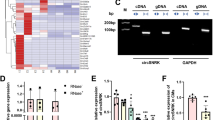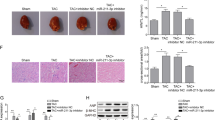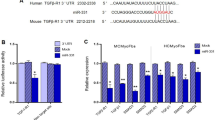Abstract
Cardiac fibrosis is a detrimental pathological process, which constitutes the key factor for adverse cardiac structural remodeling leading to heart failure and other critical conditions. Circular RNAs (circRNAs) have emerged as important regulators of various cardiovascular diseases. It is known that several circRNAs regulate gene expression and pathological processes by binding miRNAs. In this study we investigated whether a novel circRNA, named circNSD1, and miR-429-3p formed an axis that controls cardiac fibrosis. We established a mouse model of myocardial infarction (MI) for in vivo studies and a cellular model of cardiac fibrogenesis in primary cultured mouse cardiac fibroblasts treated with TGF-β1. We showed that miR-429-3p was markedly downregulated in the cardiac fibrosis models. Through gain- and loss-of-function studies we confirmed miR-429-3p as a negative regulator of cardiac fibrosis. In searching for the upstream regulator of miR-429-3p, we identified circNSD1 that we subsequently demonstrated as an endogenous sponge of miR-429-3p. In MI mice, knockdown of circNSD1 alleviated cardiac fibrosis. Moreover, silence of human circNSD1 suppressed the proliferation and collagen production in human cardiac fibroblasts in vitro. We revealed that circNSD1 directly bound miR-429-3p, thereby upregulating SULF1 expression and activating the Wnt/β-catenin pathway. Collectively, circNSD1 may be a novel target for the treatment of cardiac fibrosis and associated cardiac disease.

This is a preview of subscription content, access via your institution
Access options
Subscribe to this journal
Receive 12 print issues and online access
$259.00 per year
only $21.58 per issue
Buy this article
- Purchase on Springer Link
- Instant access to full article PDF
Prices may be subject to local taxes which are calculated during checkout









Similar content being viewed by others
References
Frangogiannis NG. Cardiac fibrosis. Cardiovasc Res. 2021;117:1450–88.
Frangogiannis NG. Cardiac fibrosis: cell biological mechanisms, molecular pathways and therapeutic opportunities. Mol Asp Med. 2019;65:70–99.
Gupta S, Ge Y, Singh A, Gräni C, Kwong RY. Multimodality imaging assessment of myocardial fibrosis. JACC Cardiovasc Imaging. 2021;14:2457–69.
Peng M, Yang M, Lu Y, Lin S, Gao H, Xie L, et al. Huoxin pill inhibits isoproterenol-induced transdifferentiation and collagen synthesis in cardiac fibroblasts through the TGF-β/Smads pathway. J Ethnopharmacol. 2021;275:114061.
Yuan J, Liu H, Gao W, Zhang L, Ye Y, Yuan L, et al. MicroRNA-378 suppresses myocardial fibrosis through a paracrine mechanism at the early stage of cardiac hypertrophy following mechanical stress. Theranostics. 2018;8:2565–82.
Wang K, Gan TY, Li N, Liu CY, Zhou LY, Gao JN, et al. Circular RNA mediates cardiomyocyte death via miRNA-dependent upregulation of MTP18 expression. Cell Death Differ. 2017;24:1111–20.
Misir S, Wu N, Yang BB. Specific expression and functions of circular RNAs. Cell Death Differ. 2022;29:481–91.
Zhang ZH, Wang Y, Zhang Y, Zheng SF, Feng T, Tian X, et al. The function and mechanisms of action of circular RNAs in urologic cancer. Mol Cancer. 2023;22:61.
Altesha MA, Ni T, Khan A, Liu K, Zheng X. Circular RNA in cardiovascular disease. J Cell Physiol. 2019;234:5588–600.
Liu X, Tong Y, Xia D, Peng E, Yang X, Liu H, et al. Circular RNAs in prostate cancer: biogenesis, biological functions, and clinical significance. Mol Ther Nucleic Acids. 2021;26:1130–47.
Gu X, Jiang YN, Wang WJ, Zhang J, Shang DS, Sun CB, et al. Comprehensive circRNA expression profile and construction of circRNA-related ceRNA network in cardiac fibrosis. Biomed Pharmacother. 2020;125:109944.
Li X, Guo L, Wang J, Yang X. Pro-fibrotic and apoptotic activities of circARAP1 in myocardial ischemia-reperfusion injury. Eur J Med Res. 2023;28:84.
Zhang L, Lou Q, Zhang W, Yang W, Li L, Zhao H, et al. CircCAMTA1 facilitates atrial fibrosis by regulating the miR-214-3p/TGFBR1 axis in atrial fibrillation. J Mol Histol. 2023;54:55–65.
Li F, Long TY, Bi SS, Sheikh SA, Zhang CL. CircPAN3 exerts a profibrotic role via sponging miR-221 through FoxO3/ATG7-activated autophagy in a rat model of myocardial infarction. Life Sci. 2020;257:118015.
Liu W, Wang Y, Qiu Z, Zhao R, Liu Z, Chen W, et al. CircHIPK3 regulates cardiac fibroblast proliferation, migration and phenotypic switching through the miR-152-3p/TGF-β2 axis under hypoxia. PeerJ. 2020;8:e9796.
Ni H, Li W, Zhuge Y, Xu S, Wang Y, Chen Y, et al. Inhibition of circHIPK3 prevents angiotensin II-induced cardiac fibrosis by sponging miR-29b-3p. Int J Cardiol. 2019;292:188–96.
Zhou B, Yu JW. A novel identified circular RNA, circRNA_010567, promotes myocardial fibrosis via suppressing miR-141 by targeting TGF-β1. Biochem Biophys Res Commun. 2017;487:769–75.
Li H, Xu JD, Fang XH, Zhu JN, Yang J, Pan R, et al. Circular RNA circRNA_000203 aggravates cardiac hypertrophy via suppressing miR-26b-5p and miR-140-3p binding to Gata4. Cardiovasc Res. 2020;116:1323–34.
Wang Y, Li C, Zhao R, Qiu Z, Shen C, Wang Z, et al. CircUbe3a from M2 macrophage-derived small extracellular vesicles mediates myocardial fibrosis after acute myocardial infarction. Theranostics. 2021;11:6315–33.
Li XX, Mu B, Li X, Bie ZD. circCELF1 inhibits myocardial fibrosis by regulating the expression of DKK2 through FTO/m(6)A and miR-636. J Cardiovasc Transl Res. 2022;15:998–1009.
Guo J, Chen LW, Huang ZQ, Guo JS, Li H, Shan Y, et al. Suppression of the inhibitory effect of circ_0036176-translated Myo9a-208 on cardiac fibroblast proliferation by miR-218-5p. J Cardiovasc Transl Res. 2022;15:548–59.
Sun LY, Zhao JC, Ge XM, Zhang H, Wang CM, Bie ZD. Circ_LAS1L regulates cardiac fibroblast activation, growth, and migration through miR-125b/SFRP5 pathway. Cell Biochem Funct. 2020;38:443–50.
Wu N, Li C, Xu B, Xiang Y, Jia X, Yuan Z, et al. Circular RNA mmu_circ_0005019 inhibits fibrosis of cardiac fibroblasts and reverses electrical remodeling of cardiomyocytes. BMC Cardiovasc Disord. 2021;21:308.
Zhu Y, Pan W, Yang T, Meng X, Jiang Z, Tao L, et al. Upregulation of circular RNA circNFIB attenuates cardiac fibrosis by sponging miR-433. Front Genet. 2019;10:564.
Pang P, Si W, Wu H, Wang C, Liu K, Jia Y, et al. The circular RNA circHelz enhances cardiac fibrosis by facilitating the nuclear translocation of YAP1. Transl Res J Lab Clin Med. 2023;257:30–42.
Zhang L, Bian YF, Bai R, Song XS, Liang B, Xiao CS. Circ_BMP2K enhances the regulatory effects of miR-455-3p on its target gene SUMO1 and thereby inhibits the activation of cardiac fibroblasts. Biochem Cell Biol. 2020;98:583–90.
Ma CX, Wei ZR, Sun T, Yang MH, Sun YQ, Kai KL, et al. Circ-sh3rf3/GATA-4/miR-29a regulatory axis in fibroblast-myofibroblast differentiation and myocardial fibrosis. Cell Mol Life Sci. 2023;80:50.
Lindsey ML, Kassiri Z, Virag JAI, de Castro Brás LE, Scherrer-Crosbie M. Guidelines for measuring cardiac physiology in mice. Am J Physiol Heart Circ Physiol. 2018;314:H733–52.
Lindsey ML, Bolli R, Canty JM Jr., Du XJ, Frangogiannis NG, Frantz S, et al. Guidelines for experimental models of myocardial ischemia and infarction. Am J Physiol Heart Circ Physiol. 2018;314:H812–38.
Zhang H, Hu J, Liu L. MiR-200a modulates TGF-β1-induced endothelial-to-mesenchymal shift via suppression of GRB2 in HAECs. Biomed Pharmacother. 2017;95:215–22.
Liao J, Zhang Z, Yuan Q, Liu Q, Kuang J, Fang Y, et al. A lncRNA Gpr137b-ps/miR-200a-3p/CXCL14 axis modulates hepatic stellate cell (HSC) activation. Toxicol Lett. 2021;336:21–31.
Tai Y, Zhao C, Lan T, Zhang L, Xiao Y, Tong H, et al. Integrated analysis of hepatic miRNA and mRNA expression profiles in the spontaneous reversal process of liver fibrosis. Front Genet. 2021;12:706341.
Song Y, Tran M, Wang L, Shin DJ, Wu J. MiR-200c-3p targets SESN1 and represses the IL-6/AKT loop to prevent cholangiocyte activation and cholestatic liver fibrosis. Lab Invest. 2022;102:485–93.
Ramachandran S, Ilias Basha H, Sarma NJ, Lin Y, Crippin JS, Chapman WC, et al. Hepatitis C virus induced miR200c down modulates FAP-1, a negative regulator of Src signaling and promotes hepatic fibrosis. PLoS One. 2013;8:e70744.
Li XY, Wang SS, Han Z, Han F, Chang YP, Yang Y, et al. Triptolide restores autophagy to alleviate diabetic renal fibrosis through the miR-141-3p/PTEN/Akt/mTOR pathway. Mol Ther Nucleic Acids. 2017;9:48–56.
Zhang T, Zhang G, Yang W, Chen H, Hu J, Zhao Z, et al. Lnc-PFAR facilitates autophagy and exacerbates pancreatic fibrosis by reducing pre-miR-141 maturation in chronic pancreatitis. Cell Death Dis. 2021;12:996.
Yeruva L, Pouncey DL, Eledge MR, Bhattacharya S, Luo C, Weatherford EW, et al. MicroRNAs modulate pathogenesis resulting from chlamydial infection in mice. Infect Immun. 2017;85:e00768–16.
Wan J, Lin S, Yu Z, Song Z, Lin X, Xu R, et al. Protective effects of microRNA-200b-3p encapsulated by mesenchymal stem cells-secreted extracellular vesicles in myocardial infarction via regulating bcl2L11. J Am Heart Assoc. 2022;11:e024330.
Wu J, Subbaiah KCV, Xie LH, Jiang F, Khor ES, Mickelsen D, et al. Glutamyl-prolyl-tRNA synthetase regulates proline-rich pro-fibrotic protein synthesis during cardiac fibrosis. Circ Res. 2020;127:827–46.
Dhoot GK, Gustafsson MK, Ai X, Sun W, Standiford DM, Emerson CP Jr. Regulation of Wnt signaling and embryo patterning by an extracellular sulfatase. Science. 2001;293:1663–6.
Nawroth R, van Zante A, Cervantes S, McManus M, Hebrok M, Rosen SD. Extracellular sulfatases, elements of the wnt signaling pathway, positively regulate growth and tumorigenicity of human pancreatic cancer cells. PLoS One. 2007;2:e392.
Yousefi F, Soltani BM. Circular RNAs as potential theranostics in the cardiac fibrosis. Heart Fail Rev. 2021;26:195–203.
Liu CX, Chen LL. Circular RNAs: characterization, cellular roles, and applications. Cell. 2022;185:2016–34.
Tran AM, Chalbatani GM, Berland L, Cruz De Los Santos M, Raj P, Jalali SA, et al. A new world of biomarkers and therapeutics for female reproductive system and breast cancers: circular RNAs. Front Cell Dev Biol. 2020;8:50.
Cui C, Yang J, Li X, Liu D, Fu L, Wang X. Functions and mechanisms of circular RNAs in cancer radiotherapy and chemotherapy resistance. Mol Cancer. 2020;19:58.
Van Zonneveld AJ, Kölling M, Bijkerk R, Lorenzen JM. Circular RNAs in kidney disease and cancer. Nat Rev Nephrol. 2021;17:814–26.
Chen LL. The expanding regulatory mechanisms and cellular functions of circular RNAs. Nat Rev Mol cell Biol. 2020;21:475–90.
Kansakar U, Varzideh F, Mone P, Jankauskas SS, Santulli G. Functional role of microRNAs in regulating cardiomyocyte death. Cells. 2022;11:983.
Mansour SM, El-Abhar HS, Soubh AA. MiR-200a inversely correlates with hedgehog and TGF-β canonical/non-canonical trajectories to orchestrate the anti-fibrotic effect of tadalafil in a bleomycin-induced pulmonary fibrosis model. Inflammopharmacology. 2021;29:167–82.
Wang X, Liu Y, Hou H, Shao W, Huang D, Hao Z, et al. miRNA-29 aggravates myocardial infarction via inhibiting the PI3K/mTOR/HIF1α/VEGF pathway. Aging. 2022;14:3129–42.
Zhang F, Cheng N, Du J, Zhang H, Zhang C. MicroRNA-200b-3p promotes endothelial cell apoptosis by targeting HDAC4 in atherosclerosis. BMC Cardiovasc Disord. 2021;21:172.
Li C, Niu J, Zhou B, Deng W, Deng F, Zhou Z, et al. Dexmedetomidine attenuates cisplatin-induced cognitive impairment by modulating miR-429-3p expression in rats. 3 Biotech. 2020;10:244.
Chao X, Guo L, Wang Q, Huang W, Liu M, Luan K, et al. miR-429-3p/LPIN1 axis promotes chicken abdominal fat deposition via PPARγ Pathway. Front Cell Dev Biol. 2020;8:595637.
Nguyen MT, Min KH, Lee W. Palmitic acid-induced miR-429-3p impairs myoblast differentiation by downregulating CFL2. Int J Mol Sci. 2021;22:10972.
Hammond E, Khurana A, Shridhar V, Dredge K. The role of heparanase and sulfatases in the modification of heparan sulfate proteoglycans within the tumor microenvironment and opportunities for novel cancer therapeutics. Front Oncol. 2014;4:195.
Justo T, Martiniuc A, Dhoot GK. Modulation of cell signalling and sulfation in cardiovascular development and disease. Sci Rep. 2021;11:22424.
Hu Y, Li J, Luo H, Song W, Yang J. Differential expression of COL1A1, COL1A2, COL6A3, and SULF1 as prognostic biomarkers in gastric cancer. Int J Gen Med. 2021;14:5835–43.
Perkins TN, Peeters PM, Albrecht C, Schins RPF, Dentener MA, Mossman BT, et al. Crystalline silica alters sulfatase-1 expression in rat lungs which influences hyper-proliferative and fibrogenic effects in human lung epithelial cells. Toxicol Appl Pharmacol. 2018;348:43–53.
Li Z, Zhu S, Liu Q, Wei J, Jin Y, Wang X, et al. Polystyrene microplastics cause cardiac fibrosis by activating wnt/β-catenin signaling pathway and promoting cardiomyocyte apoptosis in rats. Environ Pollut. 2020;265:115025.
Acknowledgements
This work was supported by the National Natural Science Foundation of China (82070240, 82270246, 82073844, 82070236 and 82073838), and Harbin Medical University Marshal Initiative Funding (HMUMIF-21026).
Author information
Authors and Affiliations
Contributions
C-qX, M-yZ and RZ conceived the research, contributed to the manuscript revision, and jointly supervised this work. D-nJ and S-dJ contributed significantly to data analyses and manuscript preparation. D-nJ, F-yX and S-wF performed experiments and wrote the manuscript. YJ edited the manuscript. Y-lZ, X-qL, HS, W-zC, X-yZ, XxG and B-wZ contributed animal studies and manuscript revision. Z-mD, YW and NW provided technical support.
Corresponding authors
Ethics declarations
Competing interests
The authors declare no competing interests.
Supplementary information
Rights and permissions
Springer Nature or its licensor (e.g. a society or other partner) holds exclusive rights to this article under a publishing agreement with the author(s) or other rightsholder(s); author self-archiving of the accepted manuscript version of this article is solely governed by the terms of such publishing agreement and applicable law.
About this article
Cite this article
Ji, Dn., Jin, Sd., Jiang, Y. et al. CircNSD1 promotes cardiac fibrosis through targeting the miR-429-3p/SULF1/Wnt/β-catenin signaling pathway. Acta Pharmacol Sin (2024). https://doi.org/10.1038/s41401-024-01296-7
Received:
Accepted:
Published:
DOI: https://doi.org/10.1038/s41401-024-01296-7



